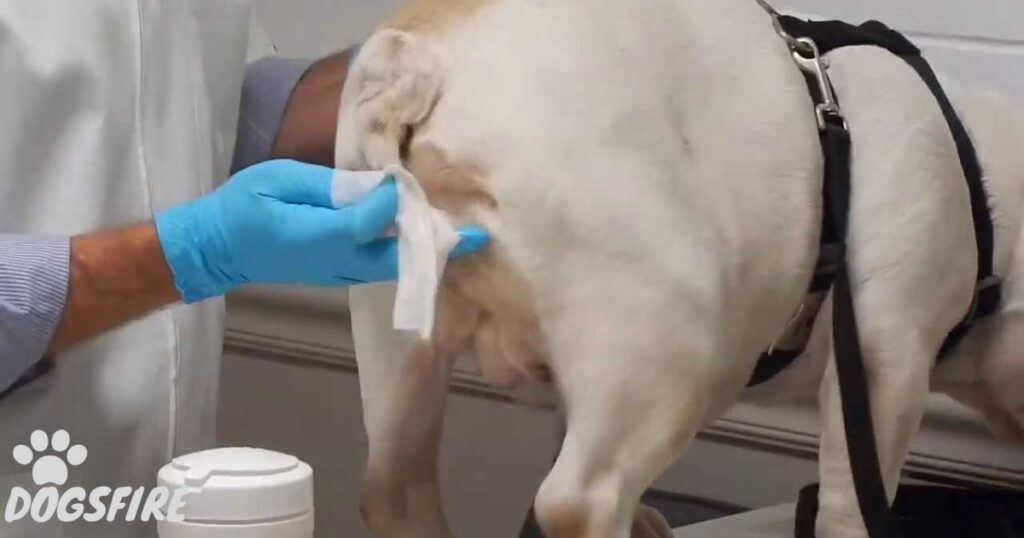I know Bulldogs have tails this is a Bulldogs are a breed of dog known for their distinctive appearance, muscular build, and loose, wrinkled skin. Despite their sturdy bodies, Bulldogs typically have short tails that are either straight or screwed. The tail is a defining feature of the breed, adding to the charm of these friendly and affectionate dogs.
We are curious about French Bulldogs have tails? These adorable pups are known for their unique tail characteristics. Discover the charming tail traits of French Bulldogs with a wag that’s sure to capture your heart.
We know French Bulldogs typically have short tails. Their tails are naturally short and straight, not long or curled. This breed is known for its compact and muscular build, with a distinctive short tail.
What Types of Tails Do French Bulldogs Have?

The French Bulldogs typically have short, straight tails. Unlike some breeds, their tails aren’t long or curled. The tail is usually carried low and is not docked. Frenchies have a smooth, compact build, and their tails complement their overall appearance.
While tails may vary slightly in length, they are generally considered short and add to the charm of these adorable dogs. French Bulldogs are known for their unique bat-like ears and distinctive tails, making them easily recognizable among dog breeds.
- French Bulldogs typically have a “screw” tail.
- The screw tail is short, compact, and may have a slight twist, resembling a corkscrew.
- This tail type is a distinctive feature and is considered a breed standard for French Bulldogs.
- French Bulldogs are brachycephalic, which means they have a short skull and flat face, influencing the length of their tails.
- While the screw tail is standard, variations such as a straight tail or minimal curl may occur.
- Deviations from the screw tail are generally considered faults in the breed standard.
- The unique appearance of the French Bulldog, including its tail, contributes to the breed’s charm and popularity.
Are French Bulldog Tails Docked?

The French Bulldog tails are not typically docked. The breed standard for French Bulldogs includes a short, compact tail with a screw-like appearance. Docking, the removal of a portion of the tail, is not a common practice for this breed.
The natural tail of a French Bulldog is an important aspect of its characteristic look. While individual variations may occur, docking is generally not done and is not encouraged in the breed standard. French Bulldogs are known for their unique appearance, and their tails play a role in defining their charm and breed characteristics.
French Bulldog Standard Tail
The French Bulldogs are known for their distinctive “screw” tail, which is a short, compact tail that often has a slight twist, resembling a corkscrew. This tail type is considered the breed standard, and it adds to the overall charm of the French Bulldog’s appearance. The screw tail is not docked, it is naturally short, in line with the breed’s brachycephalic features. Which include a short skull and a flat face.
Deviations from the screw tail are generally considered faults in the breed standard, as the unique tail contributes significantly to the characteristic look of French Bulldogs. The French Bulldog’s standard tail is a defining feature that sets the breed apart, and it plays a role in showcasing the dog’s compact and muscular build. This tail type is not only a physical characteristic but also an essential part of the breed’s identity, reflecting the breed standard that defines the ideal French Bulldog appearance.
French Bulldog Straight Tail
While the standard for French Bulldogs typically involves a distinctive “screw” tail, some individuals may have a straight tail. This variation from the typical screw tail is considered a fault in the breed standard but does occur. The straight tail still contributes to the French Bulldog’s overall charm, although it is not the ideal according to breed guidelines.
French Bulldogs with straight tails are not as common, and the breed standard prefers the characteristic screw tail. However, it’s essential to recognize that individual variations exist within the breed, and a straight tail, while not conforming to the standard, does not diminish the lovable and unique qualities that French Bulldogs are known for.
A screw Tail French Bulldog
A French Bulldog with a screw tail has a distinctive and adorable feature. The screw tail is short, compact, and often has a slight twist, resembling a corkscrew. This unique tail type is a defining characteristic of the breed and is considered the standard, contributing to the overall charm of the French Bulldog’s appearance.
The screw tail is not only cute but also a result of the breed’s brachycephalic nature, which includes a short skull and a flat face. While deviations from the screw tail may occur, a French Bulldog with this characteristic tail is widely recognized and celebrated, showcasing the breed’s compact and muscular build. The screw tail adds a touch of whimsy to the French Bulldog’s look, making them one of the most beloved and easily recognizable dog breeds.
What is a Tail Pocket on a French Bulldog?

A tail pocket on a French Bulldog is a small, natural fold of skin located underneath the base of the tail. It forms a pocket-like space where moisture, dirt, and debris can accumulate. While not all French Bulldogs have prominent tail pockets, some may develop them, especially those with deep tail folds.
It’s essential for French Bulldog owners to regularly check and clean the tail pocket to prevent infections or irritations. Gentle cleaning with a damp cloth and ensuring the area is kept dry can help maintain the hygiene of the tail pocket. Regular attention to the tail pocket is a part of responsible French Bulldog care, helping to keep the dog comfortable and healthy.
French Bulldog Tail Problems
French Bulldogs can sometimes experience tail problems, and one common issue is the development of infections in the tail pocket. Due to their unique screw tail and compact build, French Bulldogs may have folds of skin around the tail base where moisture and debris can accumulate. This can lead to bacterial or yeast infections, causing discomfort for the dog. Regular cleaning and proper hygiene practices are crucial to prevent and address such problems.
Another potential tail issue in French Bulldogs is “hemi vertebrae,” a spinal deformity that can affect the tail. This condition may cause the tail to be twisted or kinked, and in severe cases, it can lead to mobility issues. Responsible breeding practices can help minimize the risk of congenital conditions, but it’s essential for French Bulldog owners to be aware of any signs of discomfort or abnormalities in their dog’s tail and seek veterinary attention if needed.
French Bulldog Tail Pocket Infection
A French Bulldog’s tail pocket can sometimes develop infections due to moisture and debris accumulation in the folds. Regular cleaning with a damp cloth is crucial to prevent bacterial or yeast infections in this sensitive area. Owners should be attentive to signs of discomfort or redness and seek veterinary care if they suspect a tail pocket infection in their French Bulldog.
How To Properly Take Care Of French Bulldog Tails

Taking care of a French Bulldog’s tail involves regular attention to ensure their well-being. Keep the tail pocket clean by gently wiping with a damp cloth to prevent infections. Regularly inspect the tail for any signs of irritation, and if you notice any issues, seek guidance from a veterinarian. Additionally, maintain overall hygiene and keep the surrounding areas dry to promote a happy and healthy tail for your French Bulldog.
Inspect your Dog Regularly
Regularly inspect your dog’s coat, ears, and paws for any signs of issues or abnormalities. Look for ticks, lumps, redness, or changes in behavior that might indicate a health concern. Early detection through regular inspections can help ensure prompt veterinary attention and maintain your dog’s well-being.
Clean your Dog Regularly
Clean your dog regularly by giving them baths to keep their coat and skin healthy. Use a mild dog shampoo and ensure thorough rinsing to prevent skin irritation. Regular grooming helps maintain your dog’s cleanliness and overall well-being.
FAQ,s
Which bulldog is born without tails?
The French Bulldog is born without a long tail. Instead, they typically have short, corkscrew tails, adding to their unique and adorable appearance.
French bulldog with long tail?
French Bulldogs are not typically known for having long tails; they usually have short, corkscrew tails. However, variations in tail length can occur, but a long tail is not a common trait in this breed.
French bulldog Tail removal?
Removing a French Bulldog’s tail is a controversial practice and considered unnecessary. It’s generally discouraged due to the risk of complications and potential harm to the dog’s communication and balance.
What dogs are born with nub tail?
Certain dog breeds, like the French Bulldog and Boston Terrier, are often born with naturally short or “nub” tails. This trait is a result of selective breeding and is considered a characteristic of these specific breeds.
Why can’t French bulldog naturally give birth?
French Bulldogs often struggle with natural childbirth due to their small pelvis and the puppies’ relatively large heads. Caesarean sections are commonly recommended to ensure a safe and successful delivery for both the mother and puppies.
Conclusion
The question of whether French Bulldogs have tails can be answered with a simple fact: Yes, they do have tails, but their tails are typically short and often referred to as “screwy” or “corkscrew” tails. French Bulldogs are known for their unique physical features, and their tails are no exception. While not long, their tails contribute to their distinct appearance and playful personalities.
Understanding the characteristics of French Bulldog tails is important for anyone considering these adorable dogs as pets. It highlights the importance of responsible ownership, including proper care and attention to their specific needs. In summary, French Bulldogs may have short tails, but these tails are a charming aspect of their overall delightful and lovable nature.












